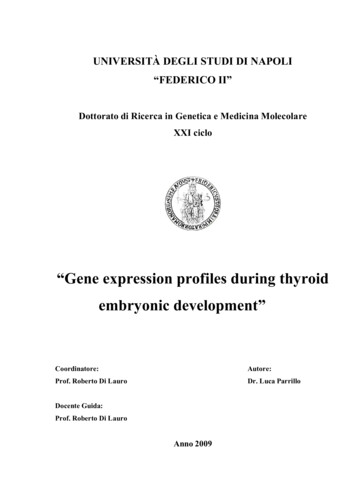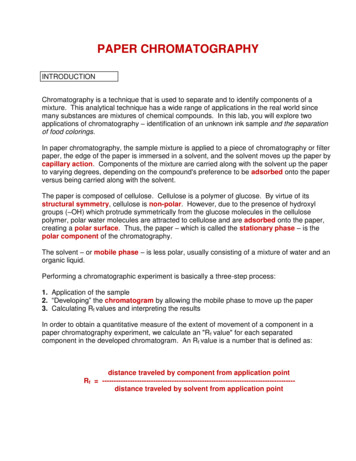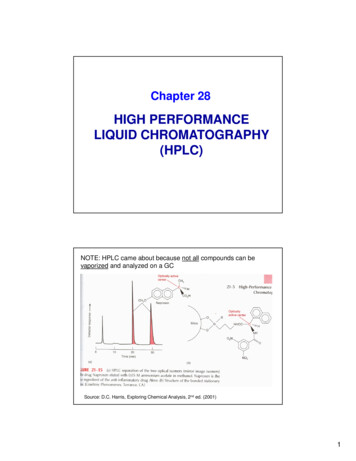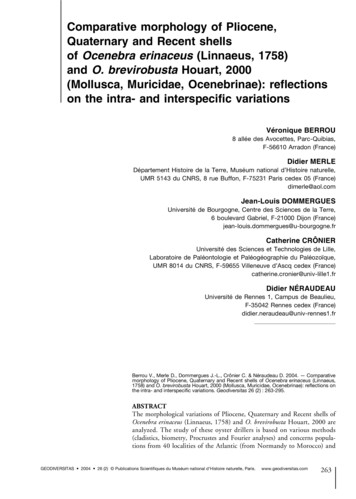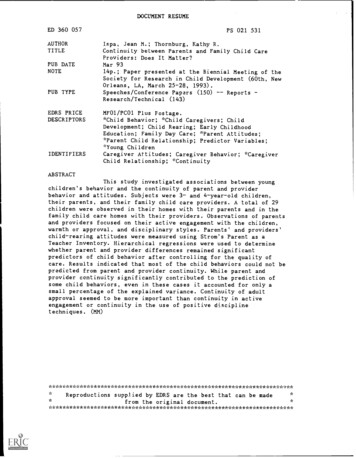
Transcription
Pliocene Warmth, Polar Amplification, and Stepped PleistoceneCooling Recorded in NE Arctic RussiaJulie Brigham-Grette et al.Science 340, 1421 (2013);DOI: 10.1126/science.1233137If you wish to distribute this article to others, you can order high-quality copies for yourcolleagues, clients, or customers by clicking here.Permission to republish or repurpose articles or portions of articles can be obtained byfollowing the guidelines here.The following resources related to this article are available online atwww.sciencemag.org (this information is current as of January 21, 2014 ):Updated information and services, including high-resolution figures, can be found in the onlineversion of this article .full.htmlSupporting Online Material can be found /08/science.1233137.DC1.htmlThis article cites 91 articles, 14 of which can be accessed 21.full.html#ref-list-1This article appears in the following subject collections:Atmospheric mosScience (print ISSN 0036-8075; online ISSN 1095-9203) is published weekly, except the last week in December, by theAmerican Association for the Advancement of Science, 1200 New York Avenue NW, Washington, DC 20005. Copyright2013 by the American Association for the Advancement of Science; all rights reserved. The title Science is aregistered trademark of AAAS.Downloaded from www.sciencemag.org on January 21, 2014This copy is for your personal, non-commercial use only.
RESEARCH ARTICLEPliocene Warmth, Polar Amplification,and Stepped Pleistocene CoolingRecorded in NE Arctic RussiaJulie Brigham-Grette,1* Martin Melles,2 Pavel Minyuk,3 Andrei Andreev,2 Pavel Tarasov,4Robert DeConto,1 Sebastian Koenig,1 Norbert Nowaczyk,5 Volker Wennrich,2Peter Rosén,6 Eeva Haltia,5† Tim Cook,7 Catalina Gebhardt,8 Carsten Meyer-Jacob,6Jeff Snyder,9 Ulrike Herzschuh10Understanding the evolution of Arctic polar climate from the protracted warmth of the middlePliocene into the earliest glacial cycles in the Northern Hemisphere has been hindered by the lackof continuous, highly resolved Arctic time series. Evidence from Lake El’gygytgyn, in northeast(NE) Arctic Russia, shows that 3.6 to 3.4 million years ago, summer temperatures were 8 Cwarmer than today, when the partial pressure of CO2 was 400 parts per million. Multiproxyevidence suggests extreme warmth and polar amplification during the middle Pliocene, suddenstepped cooling events during the Pliocene-Pleistocene transition, and warmer than present Arcticsummers until 2.2 million years ago, after the onset of Northern Hemispheric glaciation. Our dataare consistent with sea-level records and other proxies indicating that Arctic cooling wasinsufficient to support large-scale ice sheets until the early Pleistocene.*Corresponding author. E-mail: juliebg@geo.umass.edu†Present address: Department of Geology, Lund University,Sölvegatan 12, S-223 62 Lund, Sweden.www.sciencemag.orgLacustrine Impactsediments rocks1Department of Geosciences, University of Massachusetts, 611North Pleasant Street, Amherst, MA 01003, USA. 2Institute ofGeology and Mineralogy, University of Cologne, ZuelpicherStrasse 49a, D-50674 Cologne, Germany. 3North-East Interdisciplinary Scientific Research Institute, Far East Branch ofthe Russian Academy of Sciences, Portovaya Street 16, 685000Magadan, Russia. 4Free University Berlin, Institute of GeologicalSciences, Malteser Strasse 74-100, Haus D, D-12249 Berlin,Germany. 5Helmholtz Centre Potsdam, GFZ German ResearchCentre for Geosciences, Telegrafenberg, D-14473 Potsdam,Germany. 6Department of Ecology and Environmental Science,Umeå University, SE-901 87 Umeå, Sweden. 7Department ofPhysical and Earth Sciences, Worcester State University,Worcester, MA 01602, USA. 8Alfred Wegener Institute forPolar and Marine Research, Am Handelshafen 12, D-27570Bremerhaven, Germany. 9Department of Geology, BowlingGreen State University, OH 43403, USA. 10Alfred WegenerInstitute for Polar and Marine Research, Research UnitPotsdam, Telegrafenberg A43, D-14473 Potsdam, Germany.Fig. 1. Location of LakeEl’gygytgyn and strati- Agraphic cross section. (A)9Lake El gygytgyn (star) formed103.58 Ma in NE Russia, when8671 2North America remained a5contiguous landmass (and3 4had a more continental climate), unbroken by tectonicsand glacially eroded marinetroughs (33) (map courtesyof Ron Blakely). Selected Pliocene and early Pleistocenesites mentioned in the textand supplemental materialsNWSEare shown (1, Nome; 2, GubikFormation; 3, Klondike Area;4, Lost Chicken; 5, Banks Island; 6, Hvitland Beds; 7,5011-3Lake El'gygytgynMeighen Island; 8, Strathcona55Fjord; 9, Kap København; 10,5011-1141Lz1024 A B CLodin Elv). (B) Schematic cross0Quaternarysection of the El gygytgyn123basin stratigraphy, showing(m)Pliocenethe location of ICDP sites3185011-1 and 5011-3. At sitesupposed talik/420permafrost bordercentral5011-1, three holes (1A, 1B,Buplift0km 2517and 1C) were drilled to replicate the Quaternary and upCore loss/gapImpact rockPermafrost sedimentsLacustrine sedimentspermost Pliocene sections.Hole 1C penetrated the remaining lacustrine sequence down to a depth of 318 m and then 200 m intothe impact rock sequence underneath. Lz1024 is a 16-m-long percussion piston core taken in 2003 thatfills the stratigraphic gap between the lake sediment surface and the top of drill cores 1A and 1B (18).PermafrostsedimentsTthe earlier middle Pliocene, millennial-scalevariability of cooler Pliocene climate states, andthe Pliocene/Pleistocene transition [boundaryat 2.588 Ma (7)]. The terrestrial Arctic is richin Pliocene stratigraphic sequences that docu-BBhe geologic record makes it clear thatglobal temperatures are intimately linkedto changes in atmospheric greenhouse gasconcentrations (1). Today’s CO2 levels are similarto Pliocene estimates [4.5 to 2.588 million yearsago (Ma)], ranging from 380 to 450 parts per million (ppm), or some 30% higher than preindustrial levels (2, 3). Pliocene warmth, consideredan analog for future climate scenarios, persistedacross repeated warm and cool Milankovitch cycles, raising questions concerning climate sensitivity to CO2. Moreover, it remains unclear whatmechanisms drove the amplification of polartemperatures and past reductions in sea ice (4, 5)and the eventual cooling and growth of continental Northern Hemispheric ice sheets. ThePRISM climate mapping program (6) compiledimportant global climate information for theinterval from 3.26 to 3.02 Ma but overlookedment time slices when conditions were muchwarmer than today (8–10). Yet marine sediments on the Lomonosov Ridge suggest thatthe Arctic Ocean has maintained perennial seaice (11–13) or perhaps periods of seasonal seaice since the middle Miocene (14). The discordance between terrestrial and Arctic marine recordshas remained unresolved largely because of thelack of continuous land records for comparison(15, 16).Here we present results from a continuous,middle Pliocene to early Pleistocene lacustrinerecord from the terrestrial Arctic, derived fromLake El’gygytgyn, located 100 km north of theArctic Circle in Chukotka, northeastern Russia(67 30’N, 172 05’E; Fig. 1). The basin was createdby a meteorite impact 3.58 T 0.04 Ma (17) andcontains a continuous sediment sequence recording a complete Late Cenozoic climate history oncentennial to millennial time scales. The data heredemonstrate extreme warmth and polar amplification during the middle Pliocene, stepped coolingevents during the Pliocene-Pleistocene transition,and the recurrence of Arctic summer warmth untilafter 2.2 Ma, after the paced onset of NorthernHemispheric glaciation (3, 18, 19). Recurringbut declining warmth in the Arctic borderlandshas implications for understanding the transition from a forested Arctic in the middle Plioceneto the tundra-dominated landscape of today.Moreover, the data raise questions concerningSCIENCEVOL 34021 JUNE 20131421
RESEARCH ARTICLEthe seasonal persistence of Arctic sea ice in thepast, the evolution of Northern Hemisphere icesheets, and the onset of major glacial-interglacialcycles (20, 21).Lake Setting, Core Acquisition,and MethodsAt the time of the El gygytgyn impact 3.6 Ma(17), the North American Arctic had a morecontinental geography (Fig. 1), forests reachedthe Arctic Ocean coast (10), Greenland was mostly ice-free (22, 23), and permafrost was notwidespread (10, 24). Today Lake El’gygytgynis 170 m deep and 12 km in diameter, with anarea of 110 km2 within a catchment of only293 km2 (25). It is cold, monomictic, and oligotrophic, with a summer temperature of 3 C.Distinct lake-level changes are recorded by terracesand wave-cut notches as high as 35 to 40 m aboveand 10 m below the modern lake level, with thehighest benches occurring in the early basinhistory (26, 27).The Lake El’gygytgyn region today has amean annual air temperature (MAT) of –10 C,with mean July temperatures of 8 C and average winter lows of –35 C. Mean annualprecipitation (PANN) is about 200 mm/year.Reanalysis data show that the climatology of thebasin is representative of much of the westernArctic (25). Although the lake area currently lieswithin the subzone of southern shrub tundra,today’s climatology supports only sparse vegetation, dominated by hummock and moss tundraover deep permafrost with some prostrate willowsand dwarf birch.Drilling at Lake El’gygytgyn occurred inspring 2009 from a lake-ice platform (28). Lakebasin stratigraphy is based on seismic surveys (29)suggesting continuous sedimentation over thetime period of interest. The 318-m-long composite sequence representing the complete 3.6 Marecord in International Continental Scientific Drilling Program (ICDP) core 5011-1 (Fig. 1) was investigated using initial nondestructive scanningand logging technologies along with multiproxyinvestigations on subsamples (supplementarymaterials). The core chronology is based on magnetostratigraphy and tuning of proxy data withmarine isotope stratigraphy (21) and summerinsolation at 67.5 N (30) (supplementary materials and figs. S4 and S5).The sedimentology is composed of five pelagic facies (Fig. 2D; supplementary materialsand figs. S1 and S2). One striking feature ofthe sediments is the remarkably cyclic nature ofmany proxies, including biogenic silica content(BSi%) and accumulation rate (BSi acc. rate),Si/Ti ratio, and the concentration of total organiccarbon (TOC) throughout the record youngerthan 2.65 Ma (18) (Fig. 2, E and F, and fig. S4).BSi percentage and acc. rate and Si/Ti ratios areshown to be robust proxies of the lake’s primaryproductivity, with higher values generally associated with high summer insolation and relativelylight marine isotopic values (Fig. 2, A and B).1422Similar regular cycles are not seen 2.65 Ma.In contrast, high productivity is implied by highSi/Ti ratios and BSi acc. rate from 3.3 to 3.1 Ma(Fig. 2, E and F), but in the early lake historybefore 3.2 Ma, the productivity signal is dilutedby higher clastic flux rates, as evoked by the BSiacc. rate, low Si/Ti ratios, and higher sedimentation rate (Fig. 2E and fig. S3).Mid-Pliocene ExtremeOur Lake El’gygytgyn record provides a continuous terrestrial record showing the extremeArctic warmth from 3.6 to 3.4 Ma that other,shorter records of the middle Pliocene have inferred (31). The earliest sediment history in thelake begins a few thousand years after the impact, as hydrothermal activity ceased and thecrater cooled and filled with water. The first 17 mof post-impact sediment ( the first 20,000 years)is almost devoid of pollen and other microfossils, but after 3.56 Ma, the pollen stratigraphyprovides the best descriptor of paleoenvironmental conditions (supplementary materials). Themean temperature of the warmest month (MTWM,Fig. 2H) and PANN (Fig. 2I) reconstructed fromthe pollen record imply values of 15 to 16 Cand 600 mm/year, respectively. These estimatesare 7 to 8 C warmer and 400 mm wetter thantoday. Similar values were reconstructed for thePleistocene super-interglacial marine isotope stage(MIS) 11c (18), but this time interval lacks firand hemlock pollen, highlighting the exceptional warmth and wetter conditions of the middlePliocene. Cooler intervals of the record occurat 3.46 and 3.42 Ma during summer insolationminima and maxima in the marine oxygen isotope stack (e.g., MG6).Elevated BSi deposition (Fig. 2E) suggestsgreater seasonal productivity and is consistentwith generally warmer and wetter conditions between 3.56 and 3.4 Ma. The dominant planktonicdiatom (Pliocaenicus sp.) is significantly largerthere than during any other interval in the entire lake record, suggesting extremes in nutrientdelivery and reduced seasonal ice cover. This isconsistent with higher rates of siliciclastic sedimentation, probably caused by increased precipitation, steeper relief, and reduced or absentpermafrost within the catchment (supplementary materials, fig. S3).Mid-Pliocene warmth has previously beendocumented in other parts of the terrestrial Arctic,but those records are limited in duration, precluding comparisons with orbital forcing. Nonetheless, they provide a vital spatial network ofsites for characterizing the Arctic borderlands.The Strathcona Fjord Beaver Pond dated to3.4 Ma (32) (Fig. 1, site 7) spans 40,000 years.Reconstructed MATs were continuously 19 Cwarmer than today (–1.6 C), and summer growing season temperatures were in the range of14 C (8, 9, 32). The Canadian Archipelago remained a contiguous landmass at this time (33)(Fig. 1), with forests likely extending to the coastof the Arctic Ocean (10). At the same time, sea21 JUNE 2013VOL 340SCIENCEsurface temperatures (SSTs) in the North Atlanticwere 18 C [ 7 C warmer than today (Fig. 3D)(34)], and latitudinal temperature gradients werelower (35, 36) (Fig. 3H). In Antarctica, persistentopen-water conditions in the Ross Embaymentand a reduced West Antarctic Ice Sheet from4.5 to 3.4 Ma imply 1.2 million years of continuous warmth (37) (Fig. 3J). Hence, in the midPliocene, both polar regions were substantiallywarmer than at present. At Lake El’gygytgyn,warm conditions continued even during orbitswith reduced boreal summer insolation (Fig. 2,B versus H).Pliocene-Pleistocene WarmthReconstructed MTWM (Fig. 2H) and PANN(Fig. 2I) from 3.26 to 2.2 Ma also indicate aprotracted period of warm and moist conditions 3 to 6 C warmer and 100 to 200 mm wetter than in modern times and warmer than thelast interglacial MIS 5e (18). Beyond the exceptional vegetation response (Fig. 2, G to I),BSi (Fig. 2E) and TOC (fig. S4) are also elevated during most of this time. Important exceptions to these warm conditions includemarine isotopic intervals labeled MIS 100, 96,and 86 (Fig. 2A), when MTWM estimates dipnear or below modern values (Fig. 2H) andapproach cold temperatures similar to thoseestimated by the same proxies for late Pleistocene glacial conditions [the Last Glacial Maximum (LGM), Fig. 3A]. Summers cooler thantoday are largely younger than 2.5 Ma, with onlyone exception, the M2 cooling event at 3.3 Ma.Even most early Pleistocene temperatures remained higher than those of the middle and latePleistocene.Changes in boreal forest composition occurwith the loss of conifers at 2.71 to 2.69 Ma andthen the transition from forested habitats totreeless and shrubby environments in steps at2.6, 2.56, and 2.53 Ma (Fig. 3, G and I). Thesechanges provide estimates of the mean temperature of the coldest month (MTCM; fig. S8), withimportant implications for Beringian vegetationclimate feedbacks (38) as expanding tundraincreased land surface albedo, especially during snow-covered months. These cooler vegetation types become dominant 2.53 Ma, evenduring high summer insolation orbits, except during super-interglacials 93, 91, and 87 (18) (supplementary materials). Climate-vegetation modelsimulations using 300 and 400 ppm CO2 (Fig. 4and supplementary materials) are consistentwith forest cover at Lake El’gygytgyn before 2.53 Ma and restricted glacial ice over Greenland in both cold and warm boreal summerorbits (39), especially for the PRISM intervalfrom 3.26 to 3.02 Ma (6).Cross-correlation of MTWM (Fig. 3A) withthe LR04 stack (Fig. 3B) provides a rather goodfit [correlation coefficient (R2) 0.41, fig. S8],illustrating the expected link between summertemperatures at Lake El’gygytgyn and obliquityvia the isotopic stack (Fig. 3C). Several intervalswww.sciencemag.org
RESEARCH ARTICLEof coniferous-dominated forests occurred duringMIS 101, 93, 91, and 87 interglacials (40). Summers at Lake El’gygytgyn remain 1 to 3 Cwarmer than at present for 200,000 years afterstratification of the North Pacific at 2.73 Ma(41) (Fig. 3F), even during the coldest boreal summer orbits (MIS G6, Fig. 2H). These data, alongwith eustatic sea-level reconstructions (Fig. 3E),support the notion that Pleistocene coolingand the intensification of Northern Hemisphereglaciation (NHG) were gradual, occurring inseveral steps (5, 34–36), but with warm ArcticAge (ka)220024002600280030003200340036002.5MIS 86 88LR04 0MatuyamaGaussKaenaGaussMammothEB, CA, DDEBSi acc. rate(g m-2 a-1)102first occurrence3020101Facies4.0July insolation (W m-2)3.5BSi (%)A923.01001002.01.0Si/Ti1.5FHMTWM ( C)10010080806060404020200200Spruce (%)GTrees & Shrubs (%)0.515105modernIPANN (mm a-1)8006004002002200240026002800Fig. 2. Chronology, sediment facies, and proxy data from 3.58 to2.2 Ma from Lake El’gygytgyn. (A) Global marine isotope stack (21)(ka, thousand years ago) and (B) mean July insolation for 67.5 N (30),next to (C) the magnetostratigraphy, (D) sediment facies defined in thetext and supplementary materials, (E) FTIRS-inferred biogenic silica plottedas BSi acc. rate (note logarithmic scale) and % BSi, and (F) Si/Ti ratio. Thesewww.sciencemag.org3000320034003600data are compared to (G) percent of trees and shrubs (green line) and spruce(black bars) pollen. (H) Reconstructed MTWM and (I) annual precipitation(PANN), based on the pollen spectra and the best modern analog approachapplied in (18). The darker colored line in both (H) and (I) represents themean values, whereas colored shading is the uncertainty range [modernvalues from (63)].SCIENCEVOL 34021 JUNE 20131423
RESEARCH ARTICLEland (Fig. 1, site 6), fossil plant and beetle assemblages suggest July temperatures 10 to11 C warmer than today (42). Data from several sites show that boreal forests stretchingfrom 60 to 80 N included pine, not found inmodern forests of Alaska or the Yukon (31).summers persisting much later than previouslydocumented.At Lake El’gygytgyn, the PRISM interval(Fig. 3) was nearly as warm as it was between3.56 and 3.4 Ma, and boreal forests changedlittle in composition (Fig. 3G). At Meighen Is-Age (ka)240026002800300032003400Holocene avg.10Benthic δ O (‰)3.620184.01620800-20PRISM M260-40-60-804020250CEwarmcool mixed forestcold deciduous forestcold steppecold1060840206042Northern Hemispheric Glaciation240026002800 Age (ka)3000320034003600MudSand Grav.2200N321 JUNE 2013Mudstone/sandstoneVOL 340SCIENCESiltstonewww.sciencemag.orgR4 N53.596 3.56 4.294.493 4.783.330 2.21DiatomiteN4R33.03R2 1.945 2.01Age(Ma)Polarity2.581 2.79 2.87 2.87( C)ODP 846 - ODP 1012300-100cool conifer forestLithologic logAND-1BEustatic sea level(m)4012taigaJ350140HBLake El‘gygytgyn Lake El‘gygytgynspruce pollen (%) dominant biomeFODP 982AUk'37 SST ( C)0400183.2D4502.85Atm. p CO2 (ppm)15tundra1424360020LGM avg. MTWM ( C)ALake El‘gygytgyn2200ODP 882 BSi acc. rate(g m-2 a-1)Fig. 3. Global proxies of changecompared to Lake El’gygytgyn.(A) MTWM from Fig. 2, with solidhorizontal lines shown as meanvalues over the selected intervals;the long dashed line is the Holocene average temperature, andthe short dashed line is the LGMaverage temperature from (18).(B) Benthic marine LR04 stack(21); (C) changes in pCO2 shownas a range window in yellow, estimated from minimum and maximum of (2), with low-resolutionestimates using boron methods(orange and red solid circles) in(3); (D) alkenone reconstructedSSTs for the North Atlantic (34)(ODP, Ocean Drilling Program);(E) eustatic sea-level record fromNew Zealand, representative ofthe global stack (55); (F) massaccumulation rate of biogenic silicafrom the North Pacific (41); (G)dominant reconstructed biomesfrom Lake El’gygytgyn; (H) changein SST gradient between the NorthPacific tropics and subtropics from(59); (I) percent of spruce pollen;compared with (J) lithology ofANDRILL core ANT-1B from a depthof 438 to 190 m in (37). The bluevertical shading is the M2 isotopic event, and the gray verticalbar is the PRISM research interval. The dashed vertical line marks2.72 Ma.Yet the average MTWM reconstructed over thePRISM interval is slightly warmer ( 1.5 C) thanin multimodel climate simulations of the PlioceneModel Intercomparison Project (PlioMIP) (43).In the PlioMIP simulations using eight different coupled atmosphere-ocean general circula-DiamictiteVolcanicGI
RESEARCH ARTICLEtion models (43), the multimodel MAT at LakeEl gygytgyn is 7.05 T 2.7 C warmer than inpreindustrial times and the MTWM is 5.5 T2 C warmer. The simulated MTWM is close tothe PRISM-average reconstructed warming of 7 C. However, at times during PRISM, MTWMtemperatures at the lake were 8 C (Fig. 3A)warmer than present. In sum, model sensitivityto Pliocene boundary conditions, including atmospheric CO2, appears to be slightly lower thanthe observed sensitivity at Lake El’gygytgyn.M2, Pliocene Transition, and Paceof Pleistocene CoolingThe pollen-based reconstructions from LakeEl’gygytgyn show that the largest cooling eventof the mid-Pliocene took place from 3.31 to3.28 Ma (MIS M2) (21). Conditions were coolerand dryer, as documented by a dramatic decreasein the relative abundance of arboreal pollenand increases in Artemisia, Poaceae, and otherherbaceous pollen (fig. S6). Although larch, pine,birch, alder, and possibly spruce stands remainedaround the lake, steppelike habitats dominatedA(Fig. 3G). Coprophilous fungi indirectly pointto the presence of large grazing animals, suchas mammoth, horse, and bison (40). Climaticconditions were not “glacial”; rather, it was aswarm as the Holocene average or slightly warmer(44) (Fig. 3A). This has implications for interpreting the M2 isotopic shift of 0.5 per mil inthe North Atlantic (21). Modeling sensitivity studies(39) do not preclude the existence of a GreenlandIce Sheet during M2 as a major source of icerafted debris (IRD) (45). However, if Holocenelike conditions at Lake El’gygytgyn are indicativeof broader circum-Arctic climate, conditions forthe initiation of ice over North America wouldhave been unfavorable until long after 3 Ma (46).Our results are consistent with gradual alkenonebased evidence of SST cooling in the easternNorth Atlantic in the range of 2 to 3 C (47) and6 C (34) during M2, but with ocean temperatures remaining warmer than modern ones bothbefore and after (Fig. 3D). Our findings are alsoconsistent with drilling results from the RossSea (ANDRILL), suggesting that most M2 iceadvance outside Alaska, Greenland, and SvalbardB200 ppm CO2, cold summer orbito80 N80 No70 N70oN60oN60oN50oN o060oEC120oE180oW120oW60oW0o50oN o060oED300 ppm CO2, cold summer orbit80 N80 N70oN70oN60oN60oN120oE180oW120oW60oW0o300 ppm CO2, warm summer orbito60oEE120oE180oW120oW60oW0o50oN o080oN70oN70oN60oN60oN60oE120oETundraCushion-forb tundraProstrate dwarf-shrub tundraErect dwarf-shrub tundraLow and high shrub tundraGraminoid and forb tundra180oW120oW60oW60oEF400 ppm CO2, cold summer orbit80oN50oN o0200 ppm CO2, warm summer orbitoo50oN o0took place in Antarctica rather than North America(Fig. 3J) (4, 37, 48).The gradual but paced onset of NHG tookplace as step changes starting after 3.6 Ma (49),but temperatures in the Arctic remained elevateduntil 2.2 Ma. Although records of IRD fromthe North Atlantic/Barents Sea (50) and the NorthPacific (41) indicate the presence of glacial margins reaching tidewater, IRD records do notprovide a measure of ice-sheet size. Eustaticequivalent changes in sea level, in contrast, offeran index of global ice volume (21) but not wherethe ice was located (51).Direct evidence of North American continentalscale ice sheets extending southward from Canadadoes not appear until after 2.4 Ma (52, 53) andmay have had a different geography with warmbased, subglacial conditions (54). This may explain why sea-level variability during initial coldcycles after 2.6 Ma (MIS 100) was in the range of 70 m, which is much less than 125 m for theLGM (Fig. 3E) (55). In the Alaskan Brooks Range,the earliest glacial cycles were after 2.7 Ma andwere most extensive toward the Arctic Ocean,0o60oE120oEGrassland and Dry ShrublandTemperate grasslandTropical grasslandTemperate xerophytic shrublandTropical xerophytic shrublandBarrenDesertFig. 4. Coupled climate-vegetation model simulations spanning thePliocene-Pleistocene transition. All simulations assume an ice-free Northern Hemisphere, including Greenland. CO2 atmospheric mixing ratios span therange assumed to have existed at the onset of major Pleistocene glacials [A andB; 200 ppm by volume (ppmv)], during the Pliocene-Pleistocene transition (C andD; 300 ppmv), and in the warm Pliocene (E and F; 400 ppmv). (A), (C), and (E)assume an orbital configuration like that at 116 ka, producing relatively coldboreal summers, whereas (B), (D), and (F) use a warm boreal summer orbit likewww.sciencemag.org180oW120oW60oW0o400 ppm CO2, warm summer orbit50oN o0Boreal ForestCold deciduous forestCold evergreen needleaf forest120oE180oW120oW60oW0oTemperate ForestTemperate deciduous forestCold mixed forestCool conifer forestCool mixed forestWarm mixed forestTemperate conifer forestthat at 125 ka. The simulations place the pollen-based vegetation reconstruction(Fig. 3G) into a spatial and temporal context, relative to proxy-based CO2 reconstructions. Although the persistent dominance of forest biomes at Lake El’gygytgynuntil 2.6 Ma is in broad agreement with the model, the lack of temperate forest at400 ppm of CO2 demonstrates either the undersensitivity of the model to CO2forcing or the possibility that Pliocene greenhouse gas levels were higher than inmost proxy reconstructions. Descriptions of the model and boundary conditionsare provided in the supplementary materials.SCIENCEVOL 34021 JUNE 20131425
RESEARCH ARTICLEsuggesting that a more sea-ice–free Arctic Oceanmay have provided an important precipitationsource (56). A major drop in the partial pressure of CO2 (pCO2) at 2.8 Ma that could havedriven additional cooling is indicated in someproxy records (3) (Fig. 3C). Increases in oceanstratification and IRD in the North Pacific fromthe mountainous Pacific Rim at 2.73 Ma (57),when inferred pCO2 is in the range of 280 to370 ppm (2, 3) (Fig. 3C), coincide with a significant drop in precipitation at Lake El’gygytgyn(Fig. 2I) and an abrupt change in boreal forestcomposition, characterized by vegetation still requiring summer temperatures warmer than theHolocene average (Fig. 3A). Thus, our vegetation record is consistent with estimates for pCO2(2, 3), but Arctic temperatures consistent withthat vegetation make it difficult to reconcile thebuildup of major continental ice sheets with summers warmer than today, even during cold Arcticsummer orbits. The substantial PANN drop at2.73 Ma (Fig. 2I) and onset of cold winter temperatures, at times colder than today (fig. S8), areconsistent with preliminary model simulationsshowing the climatic impact of large NorthernHemispheric ice sheets on the Arctic basin andBeringia (fig. S9).At Lake El’gygytgyn, the first cold “glacial”sediment, Facies A (Fig. 2D), occurs at 2.6 Ma(18); this facies, indicative of perennial summer lake-ice cover and MAT at least 4 T 0.5 Ccolder than today (58), becomes common after2.3 Ma during cooler summer orbits, after anincrease in low latitudinal temperature gradientsin the Pacific (Fig. 3H) (59). Perennial lake-icecover implied by Facies A does not appear duringall cold orbits until after 1.8 Ma (18). Likewise,the first cold interval in Lake Baikal occurs at2.7 Ma, but cyclic patterns of glacial/interglacialBSi do not take hold until after about 1.8 Ma(36, 60).Warm temperatures and changing boreal forest composition at Lake El’gygytgyn, togetherwith other proxies, contribute to a growing bodyof marine and terrestrial evidence that climatesystem change from the warm Pliocene to the latePleistocene glacial world was a punctuated sequence of stepped Northern Hemispheric coolingevents and ice buildup (34, 36, 49, 59). Althoughlatitudinal temperature gradients steepened after2.65 Ma (Fig. 3H), swings in global sea levelincrease only after 2.6 Ma (Fig. 3E), despitewarmer Arctic summers, which is consistentwith the waxing and waning of the West Antarctic Ice Sheet (Fig. 3J) (37). Polar amplificationthroughout the interval from 3.56 to 2.2 Mamakes it likely that seasonal rather than perennial Arctic sea ice (5) was the norm, particularlyduring warm summer orbits [(61) and supplementary materials].ConclusionsThe sediments recovered at Lake El’gygytgynprovide an exceptional window into environmental dynamics from a terrestrial high-latitude1426site against which other Arctic and lower-latitudepaleoenvironmental records can be compared.Although the geologic record has already informed us of extreme warmth at intervals in themiddle Pliocene [(31) and references therein],Lake El’gygytgyn provides a continuous timeseries of the timing of changes responsible fortransforming a virtually ice-free forested Arcticinto one capable of supporting major glacial cycles.Elevated warmth across cold and warm orbital cycles during the “41,000-year obliquity-dominatedworld” of the Pliocene and early Pleistocene isconsistent with pCO2 estimates of 280 to 400 ppm(2, 3, 62), but evidence of extreme polar
Pliocene Warmth, Polar Amplification, and Stepped Pleistocene Cooling Recorded in NE Arctic Russia Julie Brigham-Grette,1* Martin Melles,2 Pavel Minyuk,3 Andrei Andreev,2 Pavel Tarasov,4 Robert DeConto, 1Sebastian Koenig, Norbert Nowaczyk,5 Volker Wennrich,2 Peter Rosén,6 Eeva Haltia,5† Tim Cook,7 Catalin


